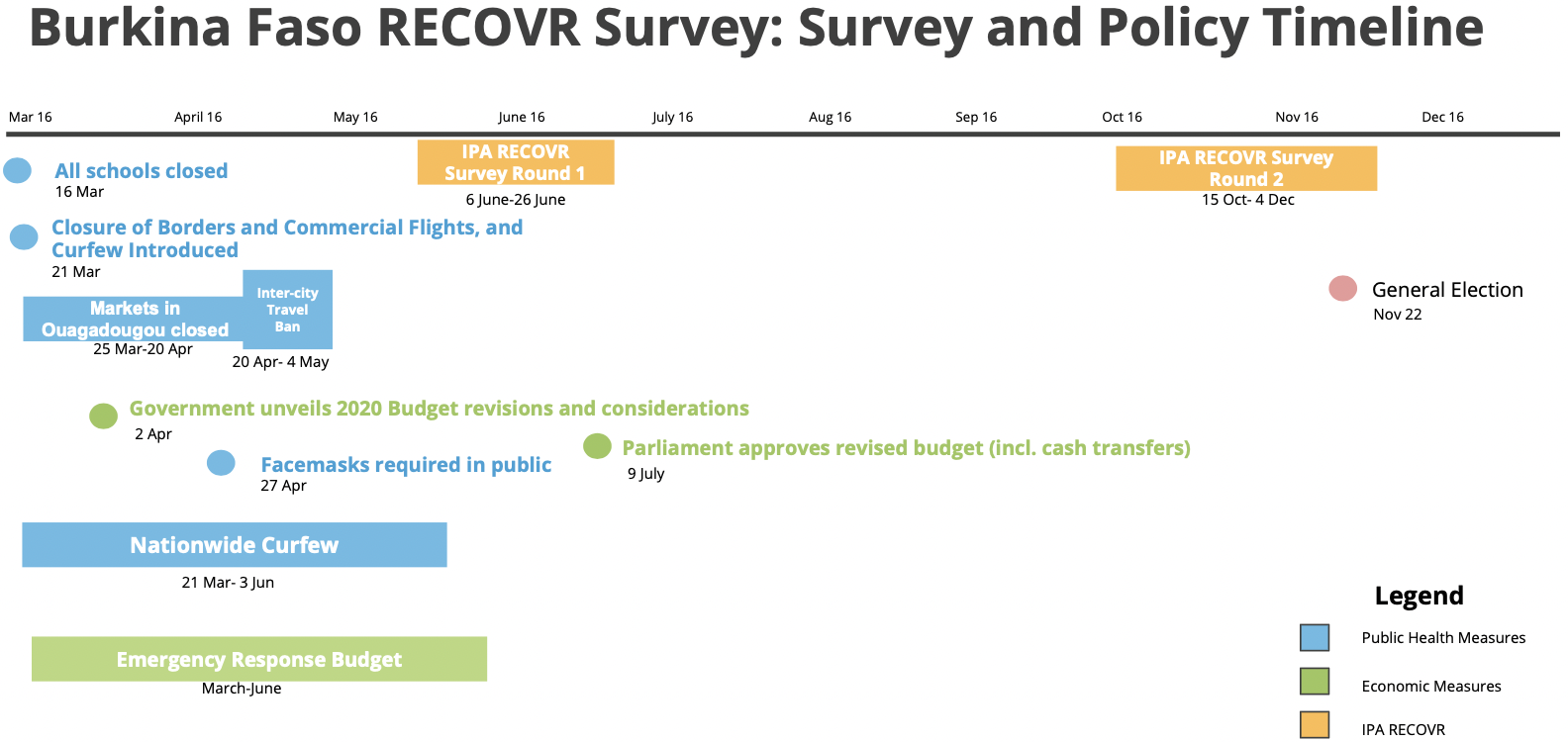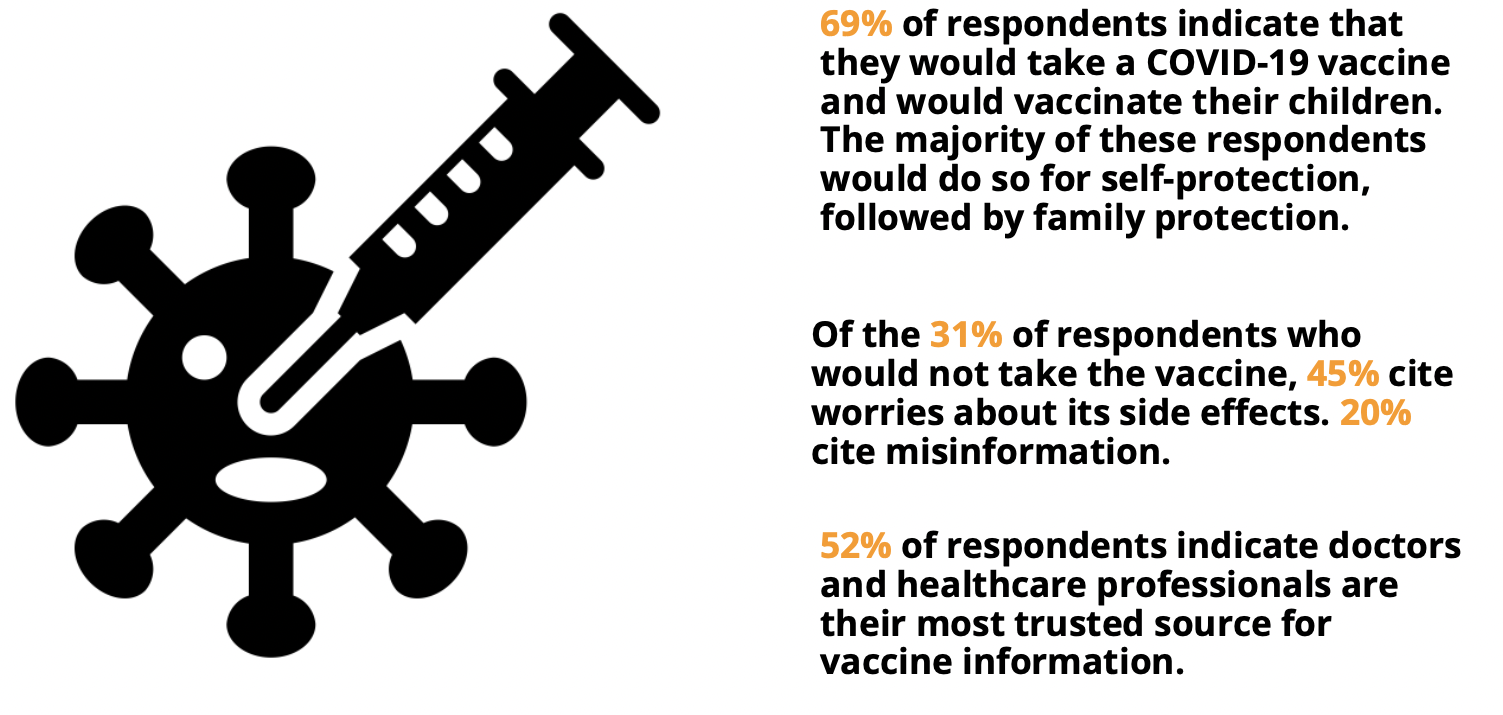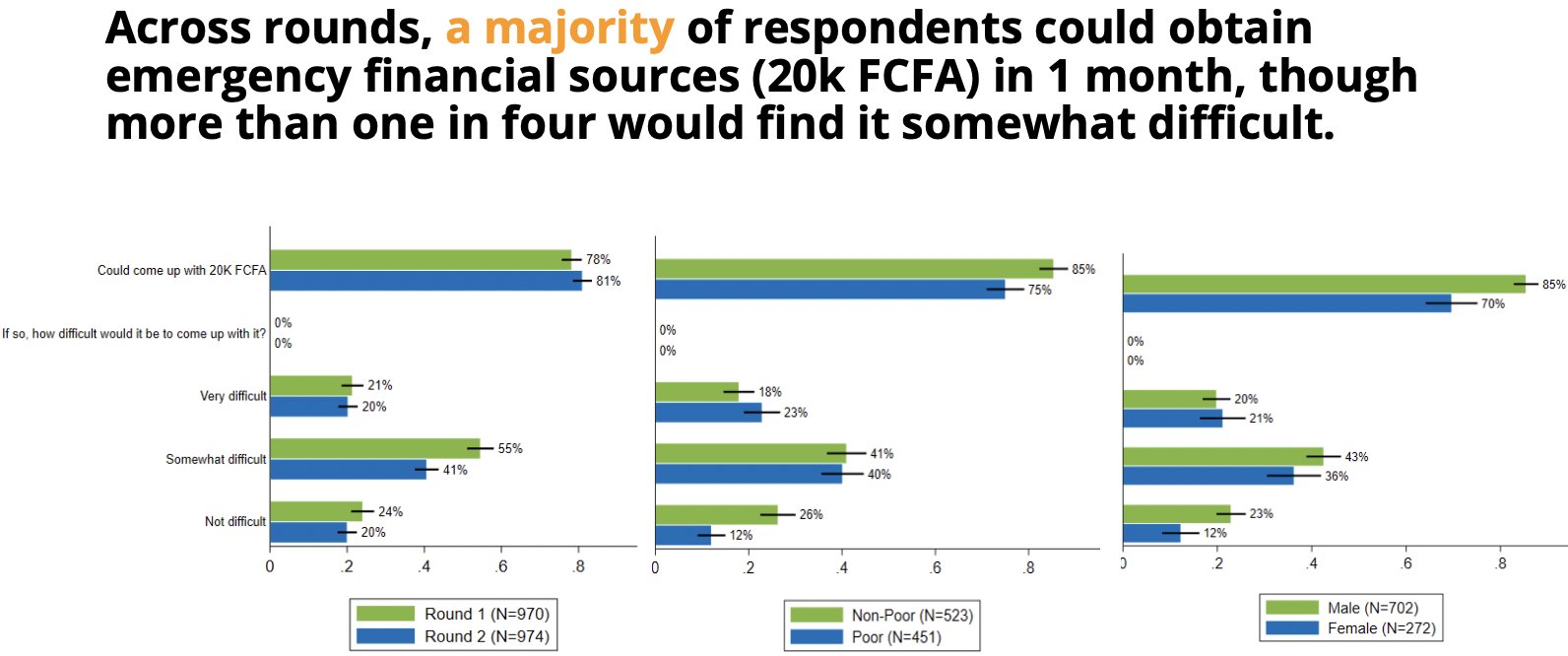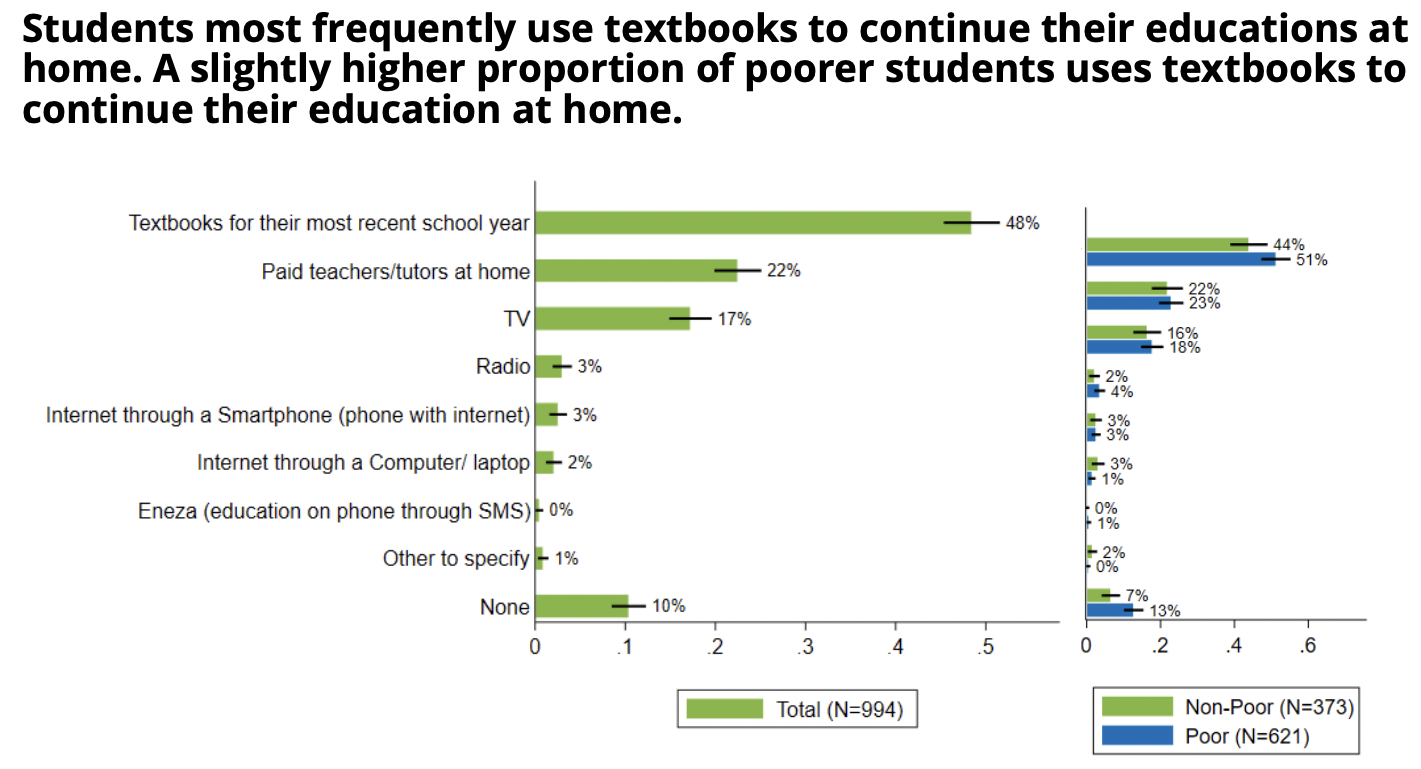The Continued Impacts of COVID-19 in Côte d'Ivoire and Burkina Faso: Lessons from Round 2 of the RECOVR Survey
IPA continues to share insights from the RECOVR multi-country panel survey, and this blog post summarizes insights related to health and COVID-19 mitigation, education, and employment and economic activity from Côte d’Ivoire and Burkina Faso. For more information, readers can also watch a recording of the webinar we recently held to highlight the results from Round 2 in West Africa. For insights from the first round, you can visit our previous blogs on Burkina Faso and Côte d’Ivoire.
IPA conducted the second round of the survey in Côte d’Ivoire from October 22nd to 30th, 2020, whereby the time the survey ended had logged 20,628 cases since the beginning of the pandemic. In Burkina Faso, the survey ran from October 15th-December 4th, 2020 (the survey was paused in the lead-up and immediate days after the November 22 elections) whereby the time the survey ended the country had reported just over 3,000 cases since the beginning of the pandemic.1 The timelines below outline further context around COVID-19 and policy responses in each country.


Burkina Faso
Health and COVID-19 Mitigation | Understanding how respondents conceive of the risk of COVID-19, and their self-reported mitigation behaviors, over time can help decision-makers to understand if messaging or other information campaigns around protection measures need to be improved or scaled.
We asked respondents how many days a week they leave their homes, and the proportion that reported leaving their homes every day of the week nearly tripled between rounds, from 23 percent to 71 percent. Important to note, however, is that of the respondents who indicate going outside the home (or receiving visitors) at least once per week, the majority (74 percent) do so for going to and from work. We also asked about face mask usage and found that the proportion of respondents who indicate that they always wear a facemask in public decreased by nine percentage points, from 93 percent to 82 percent. While this figure shows that self-reported mask usage is still high, among those who report not wearing masks, the proportion who believe it is not necessary (50 percent) nearly doubled from 27 percent. The snapshot of these self-reported behaviors suggests that consistent and clear public health messaging should continue, and also evolve to address changes in the public’s perceptions (e.g. thinking that masks are not necessary).
While a majority (69 percent) of respondents indicated that they would get vaccinated against COVID-19 and would also vaccinate their children, nearly one-third of respondents reported that they would decline a vaccine. When asked why they would not take the vaccine, 45 percent cited worries about its side effects while 20 percent also cited misinformation (note that respondents could give multiple reasons, so it is likely that there is overlap between these answers). We also inquired about the top information sources and trusted outlets respondents turn to for information about the vaccines, and just over half (52 percent) responded that doctors and healthcare professionals are their top trusted source for this information.

Employment and Financial Security | In terms of employment, a majority (81 percent) of household heads or respondents reported working in the week previous to taking the survey, around 10 percentage points more than six months prior.
A greater proportion of household heads or respondents above the country’s poverty line (86 percent) indicated working compared to those below it (76 percent). There was also a substantial gap between male and female respondents: 78 percent versus 54 percent. Such differences among the sub-groups in the survey population serve as a reminder to policymakers and practitioners that, while averages provide an important snapshot of an issue, it is critical to consider such sub-analyses to inform targeted policy responses to socioeconomic or demographic groups that may be disproportionately affected by the health and economic crisis.
The RECOVR survey also has a module on financial security, in particular, to help gauge whether respondents have access to savings or assets that can assist them in mitigating the effects of an economic shock like the pandemic. Across rounds, we saw that a majority of respondents reported that they could obtain emergency financial sources (20k FCFA2) in one month, though one in four indicated that they would find it somewhat difficult. Respondents both above the poverty line and male-identifying affirmed their ability to obtain financial sources in larger proportions than their counterparts.

Family Planning | In Burkina Faso, the RECOVR survey included a module on family planning, based on the survey co-creation process with our longstanding partner Development Media International (DMI). DMI designs engaging information campaigns, through radio and other channels, to promote evidence-based behavior change. As Dr. Abbie Clare, DMI’s Senior Research Manager, explained in the webinar, they aim to promote positive family planning behaviors in Burkina Faso amidst the pandemic.
In Round 2, 30 percent of respondents3 indicated that they are currently using contraceptives (any method). Forty-eight percent reported that they intend to use contraceptive methods in the future, which was largely consistent across rounds, and 27 percent currently use and intend to use contraceptive methods in the future. We also asked about accessibility to family planning methods, so that the government can understand any trends in this topic and develop responses accordingly. A minority of respondents indicate that accessibility has been challenging: in the first round of the survey, 18 percent of respondents indicated that accessing family planning services had been more difficult since the onset of the pandemic, and this proportion decreased to 11 percent in Round 2. Finally, under 5 percent of respondents said that girls under 18 in the household have gotten pregnant since the onset of the pandemic.
Côte d’Ivoire
Health and COVID-19 Mitigation | In Côte d’Ivoire, risk perceptions of COVID-19 were mostly consistent across rounds, though the proportion of respondents that considered that they or anyone in their household is at risk of contracting COVID-19 was still less than half (41 percent in Round 1 vs. 39 percent in Round 2). In Round 2, for the 61 percent who did not feel at risk (that they or someone in their household) of contracting the virus, the majority (77 percent) cited practicing protective measures as the main factor.
Seventy-seven percent of respondents indicated that they would get the vaccine, and this does not vary significantly by poverty status (74 percent of those above the poverty threshold versus 80 percent of those below it). Self-protection was the most popular reason respondents indicated for getting vaccinated, followed by protecting one’s family. For those who stated they would not get the vaccine, misinformation figured much less prominently (5 percent) than in Burkina Faso (20 percent).

When asked what sources respondents trust the most for information about vaccines, only 36 percent indicated that doctors and other health professionals are their top source and 15 percent indicated that the Ministry of Health is their most trusted source. We also found that poorer respondents were more likely to trust religious leaders (nine percent vs. four percent), but the overall proportion of respondents that rank religious leaders as their most trusted information source is still less than 10 percent. Notably, 15 percent of respondents said that they do not trust any person or institution for vaccine information.
Education | Educational continuity amidst schooling disruptions and distance learning is a concern for the Ivorian government, as it has been for governments around the world. IPA conducted an additional qualitative study, funded by the Jacobs Foundation in the context of the Transforming Education in Cocoa Communities (TRECC) program, to gauge parent and caregiver perceptions on distance learning, and we also highlight insights from these interviews to complement RECOVR’s quantitative results.
While the survey shows that students most frequently use textbooks to continue with remote learning (48 percent of respondents indicated this), in the qualitative interviews we found that parents often have a limited view of learning, thinking it is simply memorization. However, children’s time spent studying and reviewing textbooks without more active engagement might not be very effective. Additionally, while parents and other caregivers supported the concept of educational media, beliefs varied in relation to the type of content (e.g. over radio, TV, etc.) that would best support children’s learning.

Understanding how parents and students engage with distance education offerings is an important consideration for policymakers. The qualitative interviews revealed that, of the respondents who reported that they meaningfully engaged with radio and television programs, many felt that the instruction was too fast, and it was hard for children to keep up. These findings suggest that it is important to assess how end-users (parents and learners) are interacting with educational resources and offerings to inform any future iterations or strategies to increase uptake of educational technologies.
Employment and Economic Activity | Across most measures, workers with formal contracts were likely to be working and earning more and were less likely to have challenges accessing a bank account or experiencing food insecurity. Furthermore, among businesses with more than one employee, respondents with formal employment contracts were more likely to be working during the lockdown, earning more in the past week, and having their workplaces open without interruption.
Sixty-one percent of informal workers reported earning less income than they did before the pandemic, compared with 39 percent of formal workers. Those who were working in the informal sector were 23 percent more likely to report earning less or no income in the last week than before the pandemic, compared to those working in the formal sector. Furthermore, one-third of the informal workers reported working fewer or no hours in the last week, compared to pre-pandemic times. Such differences between formal and informal workers are echoed across findings in other RECOVR countries, where we have seen that informal workers largely have fewer resources and access to employer or state-supported benefits to weather this economic shock.
Policy Takeaways and Recommendations
What can be learned from the above insights from the RECOVR surveys, and how can decision-makers in both countries respond accordingly? As the COVID-19 pandemic continues, applying evidence-driven approaches to inform new and ongoing measures remains a critical aspect of responsive policy-making. Below, we highlight recommendations focused on health and social protection:
- Immunization: with a majority of respondents in both countries indicating that they would vaccinate themselves and (where applicable) their children, vaccination campaigns can build on this foundation by working to ensure that vaccines are easily accessible once large-scale rollouts begin. Behaviorally-based considerations, such as commitment devices and establishing social norms, can also be leveraged by policymakers in messaging and appointment logistics. IPA’s new evidence brief, Increasing Immunization in Low- and Middle-Income Countries, outlines evidence from other contexts that government agencies can incorporate to inform their own campaigns, such as mobile phone reminders, social incentives, and in-kind incentives.
- Mitigation measures: Current vaccine purchase and distribution rates worldwide mean that countries with the highest incomes are vaccinating 25 times faster than those with the lowest, according to an early-April Bloomberg News report. While the international community works to ramp up vaccine production, accessibility, and distribution, countries must continue reinforcing virus mitigation strategies such as masking and social distancing. As the RECOVR surveys show, self-reported mask-wearing and social distancing rates can vary in the population over time, so it is important for public health officials to reinforce measures as COVID-19 remains a threat.
- Family planning: In addition to continuing to fight the COVID-19 pandemic, health systems are also working to address ongoing public health challenges. A recent report by the Guttmacher Institute, Estimates of the Potential Impact of the COVID-19 Pandemic on Sexual and Reproductive Health in Low- and Middle-Income Countries, estimates that “a 10 percent proportional decline in the use of short- and long-acting reversible contraceptive methods in LMICs due to reduced access would result in an additional 49 million women with an unmet need for modern contraceptives and an additional 15 million unintended pregnancies over the course of a year.” Overall, the data in Burkina Faso did not suggest acute difficulties in accessing family planning methods and services, but this will be an important indicator for decision-makers to continue to monitor and to provide accessible information and services accordingly.
- National ID roll-out and registration to promote access to government relief: Government assistance programs globally during the pandemic have taken many forms, ranging from food distribution, in-kind donations, and cash transfers, to name a few, with various registration and eligibility requirements, and verification processes. For example, while Côte d’Ivoire has a national identification card system, there is not one singular national identification register for citizens and non-citizen residents, which poses significant challenges for social service delivery. What is more, only 45 percent of Ivoirians held national ID cards in 2017. A promising growing national health insurance system offers additional opportunities to develop a national registry, and encouraging uptakes in registration can draw more workers into formal assistance programs in the short and long term.
Finally, we invite interested readers to attend a French-language webinar of the results dissemination on May 25. You can register for the webinar here.
1. In Côte d’Ivoire, we spoke with 994 respondents from the 1,329 Round 1 respondents. In Burkina Faso, we spoke with 977 respondents from the 1,356 Round 1 respondents.
2. This amount was determined based on the example of the World Bank’s Global Findex Survey, which asks respondents of their ability to come up with 1/20 of gross national income (GNI) per capita in local currency as a base amount for emergency funds.
3. This question and the question about intended contraceptive use was asked of all male respondents and of female respondents born after 1970.











